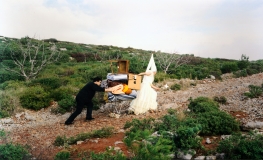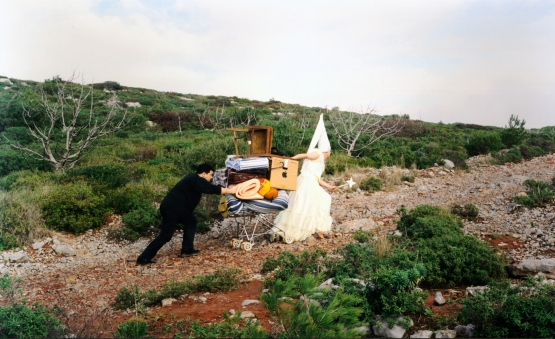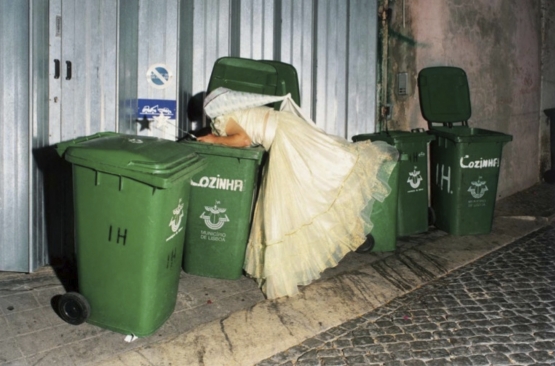THE LIFE OF THE IMAGES OF JOÃO TABARRA
Pedro Lapa
As Che Guevara said during the 1960’s, whatever
you do, that’s your trench. So this is my trench and I trust my agenda.
People misunderstand this, thinking that for the “revolution” to
succeed, everyone must literally go into the trenches. But no, we need
hairdressers, bakers, carpenters, pastry chefs, artists - not just
guerrillas. As it is impossible to ever escape ideology, maybe the only
way out is to work with the different levels of contradictions in our
culture.
Felix Gonzalez-Torres
It was from 1993 that the work of Joao Tabarra, until then exclusively in the field of photography, underwent a significant alteration. An awareness of the value of signs and of images or of the respective circulation of meanings replaced the rigor of the black and white of a photography forged out in framings that took advantage of the geometries of the spaces, served by a sensitive and poetic distribution of light. Like many other artists of his generation, he moved away from an artistic practice confined to the exploring of a medium and its possibilities, in order to deepen an interrogation on the ties that form the meanings of images. In his work, photography may thus appear as having more or less conventional characteristics, capable of being approached to the traditional and varied fields served by its literal practice; yet the respective formal rules then constitute a decoy, through a practice of a dislocating of context, framing or subtle narrative.The expectations of the observer are therefore dislocated, and the underlying conceptual aspects now make up a critical aspect. Indeed, it is important to stress that Joao Tabarra's work is not restricted to photography, but also carries out a pathway throughout other supports such as the video or the object. This is not yet the case of exploring the possibilities of a medium in the well-known Modernist manner, or of a revisiting as a scenario of a poetics anterior to the artistic work thus confined to its materialization, as happened with some conservative pathways that emerged in a post-Modern context.
The dislocation of the medium presupposes a deeper archaeology of the meanings than its literal practices reveal.The conditions of signification, whether they are semiotic, social, anthropological or political, become open to an objectivization and revealing of their intrinsic mechanisms. In this sense, a great part of the artistic work belonging to the generation of Joao Tabarra has been developed within these critical presuppositions. If many artists from a previous generation, following on from Pop Art, began a work centered on the latent ideological values and then went on to a re-utilization and critical re-contextualizing of their processes of signification, almost always taken from a social point of view, in the works of this generation - that of Joao Tabarra - the process was extended, and above all one witnesses a transit between the social and an exhibiting within the biographical and personal field, thus establishing the respective erasing of the frontiers of this dichotomy. In a certain manner,Joao Tabarra's path is exemplary as to this movement.
Throughout his work there is a clear notion of strategy going through an infiltration an intervention within recreated symptomatic situations. Direct aggression or provocative subversion are passed over as they do not arouse a communicative potential.The recognition of common situations with a vaguely narrative content functions as an operating device of interrogations that it intends to arouse in the public. In all of the works humor carries out an almost immediate seduction that permits its communicative aspect, but at the same time it is the method of analyzing and confronting the several aspects of the image, its rhetorical or even ideological intent, which are unveiled as an absurd intrigue of manipulation.The images thus appear over-codified: the gaze that devolves the mechanisms that generate it are superimposed over a clear ideological intention.The anti-heroic and 'transvested' condition of the image may be explored with irony and the humor that involves being situated on the opposite pole to the anecdote, but rather being stated as a dialogue on lucidity.
The dislocation of the medium presupposes a deeper archaeology of the meanings than its literal practices reveal.The conditions of signification, whether they are semiotic, social, anthropological or political, become open to an objectivization and revealing of their intrinsic mechanisms. In this sense, a great part of the artistic work belonging to the generation of Joao Tabarra has been developed within these critical presuppositions. If many artists from a previous generation, following on from Pop Art, began a work centered on the latent ideological values and then went on to a re-utilization and critical re-contextualizing of their processes of signification, almost always taken from a social point of view, in the works of this generation - that of Joao Tabarra - the process was extended, and above all one witnesses a transit between the social and an exhibiting within the biographical and personal field, thus establishing the respective erasing of the frontiers of this dichotomy. In a certain manner,Joao Tabarra's path is exemplary as to this movement.
Throughout his work there is a clear notion of strategy going through an infiltration an intervention within recreated symptomatic situations. Direct aggression or provocative subversion are passed over as they do not arouse a communicative potential.The recognition of common situations with a vaguely narrative content functions as an operating device of interrogations that it intends to arouse in the public. In all of the works humor carries out an almost immediate seduction that permits its communicative aspect, but at the same time it is the method of analyzing and confronting the several aspects of the image, its rhetorical or even ideological intent, which are unveiled as an absurd intrigue of manipulation.The images thus appear over-codified: the gaze that devolves the mechanisms that generate it are superimposed over a clear ideological intention.The anti-heroic and 'transvested' condition of the image may be explored with irony and the humor that involves being situated on the opposite pole to the anecdote, but rather being stated as a dialogue on lucidity.













